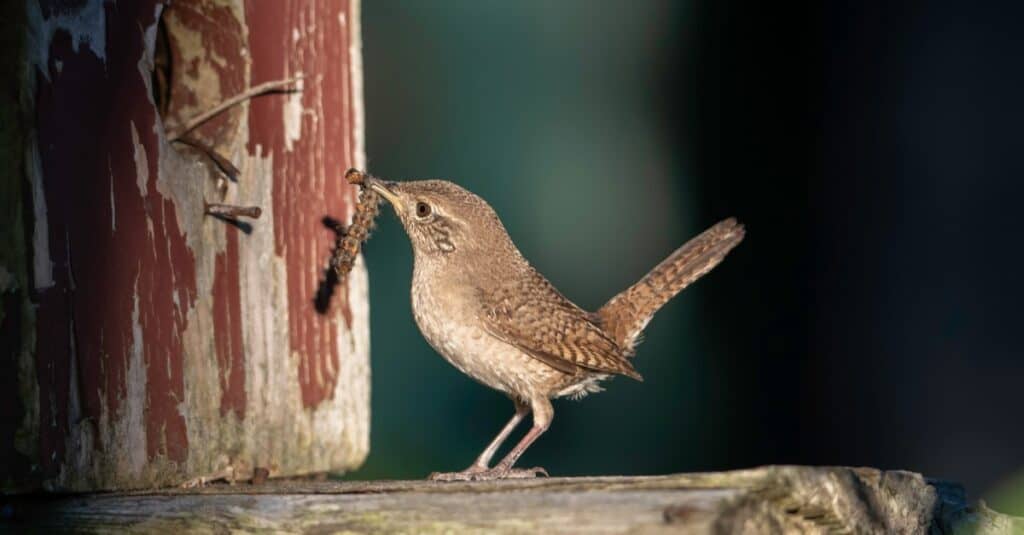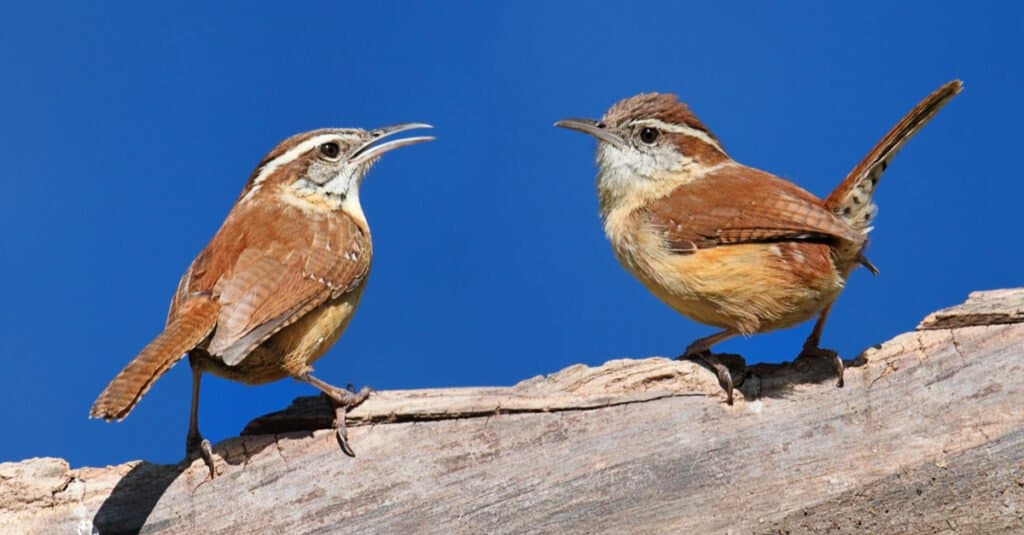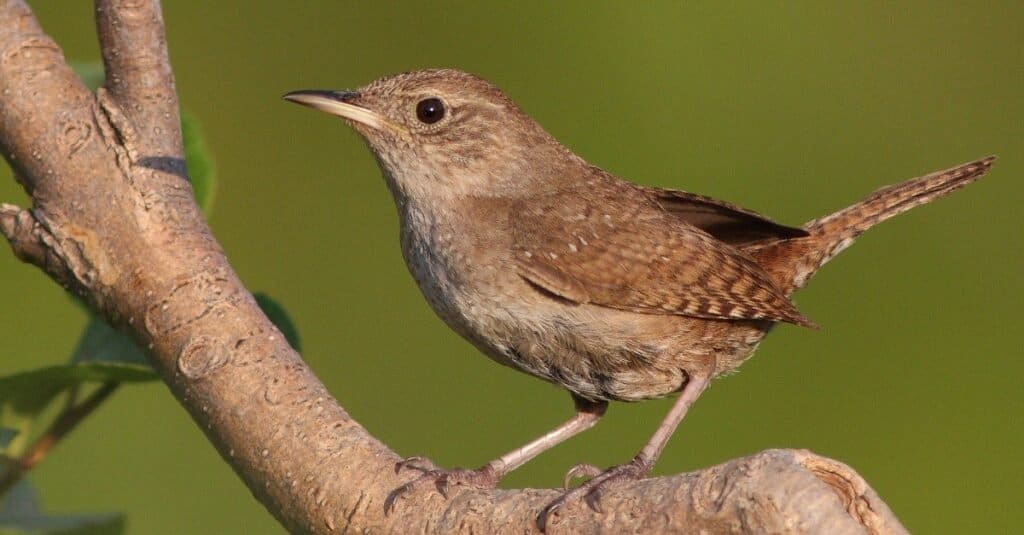Wrens are small birds that sing beautifully and with purpose. Their name comes from their song, which sounds like someone saying “wren.” Consequently, if you hear songbirds when you wake in the morning, it is likely a wren. Also, there are 88 wren species, but we will consider the differences and similarities between the house wren vs. Carolina wren.
House Wren vs. Carolina Wren: Appearance

Patrick Messier/Shutterstock.com
House wrens are small birds with flat heads and long, curved beaks. They have short wings and cock or droop their tails above their body line as a signature sign of their species. They have an average length of 4.3 inches to 5.1 inches, a wingspan of 5.9 inches, and an average weight of 0.3 to 0.4 ounces. House wrens are usually brown and have darker wings and tails. Many wren species have a pale eyebrow feature, but the house wren’s pale eyebrow feature is fainter than other wren species.
Carolina wrens have a small, round body and a long tail known to cock upwards. In addition, these birds have large heads and small necks with a long, down-curved beak. Carolina wrens are not much larger than house wrens in size, but they have a more extensive wing span and average weight. They have an average length of 4.7 inches to 5.5 inches, a wingspan of 11.4 inches, and an average weight of 0.6 to 0.8 ounces. Carolina wrens are often reddish-brown to orange in color. In addition, these birds have a white eyebrow feature, a dark bill, and a white throat.
House Wren vs. Carolina Wren: Behavior

Steve Byland/Shutterstock.com
House wrens are energetic and hop around trees and low branches. They also have an enthusiastic and cheerful song that is distinctive. Carolina wrens are prevalent in backyards and vegetated areas. These birds also cock their tails upwards while foraging and singing. Carolina wrens are constantly singing to defend their territory and assert dominance.
House Wren vs. Carolina Wren: Lifespan
The average lifespan of a house wren is seven years, while the average lifespan of a Carolina wren is six years. Therefore, the oldest house wren on record would have been over nine years old. This wren was banded in banding operations in New York in 1993. The oldest Carolina wren on record was seven years and eight months old. This wren was banded in 1997.
Mating and Nesting

Male house wrens court the female and defend their territory through singing. Male house wrens are known to have more than one mate, while female House wrens may leave the male to care for her young from her first brood before she moves to another territory and nests again. Males will build a range of nests, and the female will choose her favorite nest before completing the construction. Females make the structure by adding twigs, grass, animal hair, and feathers. Females are known to lay five to eight eggs and incubate for 12 to 15 days. Both wren parents feed their young, which leave the nest at roughly three weeks old. House wrens have two broods per year and may have three on rare occasions.
Carolina wrens are monogamous, and breeding pairs stay together for years. While together, both males and females build nests, often choosing to create them on branches, in tree holes, and on stumps. Sometimes they will make their nests on windowsills, mailboxes, and other available man-made spots. Female Carolina wrens lay roughly four eggs and incubate for two weeks. During incubation, the male Carolina wren will forage food for the female. And once the eggs hatch, both parents will feed the young before they leave the nest.
House Wren vs. Carolina Wren: Diet
If you want to create an appealing destination for house wrens, you should leave mealworms, bark butter, or sunflower chips out. In the wild, house wrens forage and find prey between bark and leaves. House wrens are known to eat:
- Small insects
- Worms
- Spiders
- Larvae
If you want Carolina wrens in your garden, leave suet, peanuts, and mealworms out for them. Carolina wrens eat the following:
- Suet
- Peanuts
- Insects
Although Carolina wrens are carnivorous, most of their diet consists of nuts and vegetation.

House Wren Fun Facts
- House wrens puncture the eggs or kick out the young of other birds that nest in cavities. They do this to protect their own eggs and young from foreign birds in their territory.
- Both the male and female house wrens sing competitively and the outcome of prolific singing by the females means that they lose fewer eggs to ovicide.
- If you would like to attract house wrens to your home, painting a nest box in red or green is likely to attract them.
- House wrens build their nests with natural materials, like grass, hair, and feathers. However, they also make nests from materials like paper clips, wires, staples, tacks, nails, lint, hooks, fasteners, and bobby pins.
Carolina Wren Fun Facts
- Carolina wrens are sensitive to cold weather, resulting in northern populations decreasing in size after severe winters.
- Only the male Carolina wren sings loudly, which is unusual as both genders typically sing in this species.
- One caged male Carolina wren is reported to have sung nearly 3,000 times in a single day.
- Carolina wrens are monogamous, and pairs are known to forage and stay together in their territory all year-round.
Up Next
The post House Wren vs. Carolina Wren appeared first on AZ Animals.
from Animal News, Facts, Rankings, and More! - AZ Animals https://ift.tt/DYPknVI